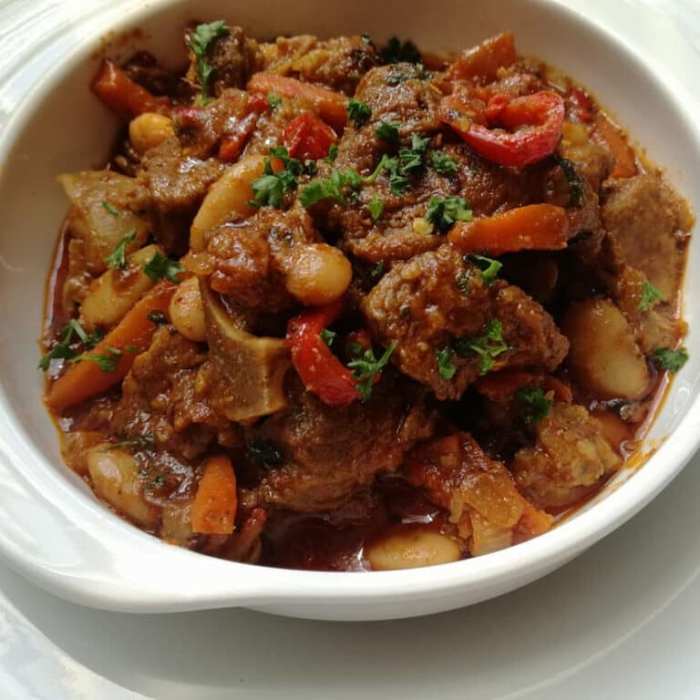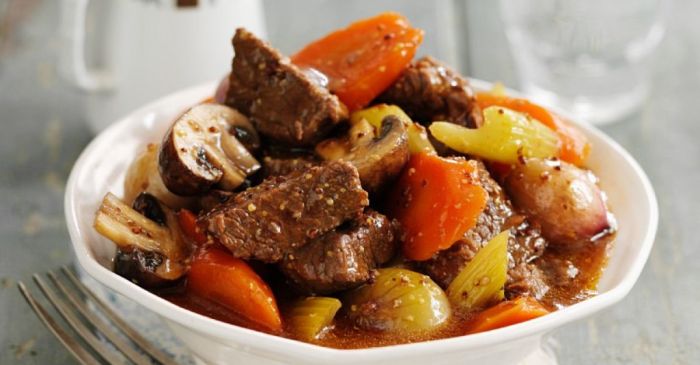Beef Stew Recipe Worcestershire Sauce Mastery
Beef Stew Recipe Variations with Worcestershire Sauce: Beef Stew Recipe Worcestershire Sauce
Beef stew recipe worcestershire sauce – Worcestershire sauce, with its complex blend of savory, umami, and subtly sweet notes, adds depth and richness to beef stew. This article explores various beef stew recipes highlighting the versatility of Worcestershire sauce, different beef cuts, alternative ingredients, and cooking techniques.
Beef Stew Recipe Variations
Three variations of beef stew are presented below, each utilizing a different beef cut and showcasing the unique flavor profiles achievable with Worcestershire sauce.
| Beef Cut | Cooking Method | Cooking Time | Beef Texture |
|---|---|---|---|
| Chuck Roast | Slow Cooker | 6-8 hours on low | Tender and fall-apart |
| Brisket | Stovetop | 2-3 hours | Tender but holds its shape |
| Short Ribs | Pressure Cooker | 1-1.5 hours | Extremely tender, almost melts in your mouth |
In the chuck roast stew, the long, slow cooking time allows the Worcestershire sauce to deeply penetrate the meat, resulting in a rich, savory flavor. The brisket stew, cooked on the stovetop, benefits from the Worcestershire sauce’s ability to create a flavorful braising liquid. The short ribs, pressure-cooked, achieve maximum tenderness, while the Worcestershire sauce adds a depth of flavor that complements the richness of the meat.
Worcestershire Sauce Alternatives
While Worcestershire sauce is ideal, several substitutes can achieve similar results. The following alternatives offer distinct flavor profiles, influencing the overall taste of the beef stew.
- Soy Sauce: Provides a salty, umami base, but lacks the complexity of Worcestershire. The stew will be less nuanced, with a more pronounced salty taste.
- Advantages: Widely available, affordable.
- Disadvantages: Lacks the depth and complexity of Worcestershire sauce.
- Liquid Aminos: Offers a similar umami punch to soy sauce but with a slightly sweeter and less salty profile. The stew will have a smoother, less aggressive savory flavor.
- Advantages: Gluten-free, often considered a healthier alternative to soy sauce.
- Disadvantages: Can be more expensive than soy sauce.
- Steak Sauce: Adds a bold, savory flavor with hints of garlic and other spices. The stew will have a more intense, robust taste.
- Advantages: Easily accessible, readily adds savory depth.
- Disadvantages: Can overpower other flavors if used excessively.
Ingredient Exploration: Vegetables and Beef Browning, Beef stew recipe worcestershire sauce

Source: recipes-ideas.com
The selection of vegetables significantly impacts the beef stew’s flavor and texture. Proper browning of the beef is crucial for developing a rich, complex flavor profile.
Vegetables like carrots, potatoes, celery, and onions complement the Worcestershire sauce’s savory notes. Root vegetables add sweetness and earthiness, while mushrooms provide an umami depth. Leafy greens, added towards the end of cooking, provide a fresh contrast.
Browning the beef before adding it to the stew is essential. This process creates a Maillard reaction, developing a deep, rich flavor and a beautiful brown crust. To brown the beef, sear it in batches over medium-high heat in a hot pan with a small amount of oil until nicely browned on all sides. This adds significant depth to the final stew.
| Thickening Agent | Method | Effect on Consistency |
|---|---|---|
| Cornstarch | Mix with cold water before adding to the stew | Creates a smooth, slightly glossy consistency |
| Flour | Make a roux (flour and fat) before adding liquid | Creates a thicker, richer consistency |
| Potatoes | Use starchy potatoes like russets | Naturally thickens the stew as they cook |
Cooking Methods and Techniques
Different cooking methods impact the tenderness of the beef and the intensity of the Worcestershire sauce flavor. Slow cooking, stovetop cooking, and pressure cooking each offer unique advantages.
Slow Cooker Method:
- Brown the beef cubes.
- Sauté onions, carrots, and celery.
- Combine all ingredients in a slow cooker.
- Cook on low for 6-8 hours or high for 3-4 hours.
Slow cooking renders the beef incredibly tender, allowing the Worcestershire sauce to infuse deeply. Stovetop cooking provides more control over the braising process, while pressure cooking delivers the quickest results with exceptionally tender beef. However, the intensity of the Worcestershire flavor may vary slightly depending on the cooking method and time.
- Common Mistake: Overcrowding the pot. This prevents proper browning and even cooking.
- Solution: Brown the beef in batches.
- Common Mistake: Not seasoning adequately.
- Solution: Season generously with salt, pepper, and other herbs.
Serving Suggestions and Pairings

Source: eatsmarter.com
Beef stew is a versatile dish with numerous serving options. The ideal texture is tender beef with a rich, flavorful broth, neither too thick nor too thin.
- Serve with crusty bread for dipping.
- Pair with mashed potatoes or creamy polenta.
- Top with fresh herbs like parsley or thyme.
- Serve alongside a simple green salad.
- Add dumplings or noodles for extra heartiness.
- Red wine, particularly a Cabernet Sauvignon or Merlot.
- Stout beer.
- A full-bodied ale.
Visual Representation
A perfectly cooked beef stew should have a rich, deep brown color, reflecting the browning of the beef and the depth of the Worcestershire sauce. The beef should be tender and easily pulled apart, while the vegetables should be cooked through but still retain some texture. The aroma should be warm, inviting, and deeply savory, with hints of Worcestershire sauce’s signature umami notes.
FAQ Section
Can I freeze beef stew?
A rich beef stew benefits greatly from the umami depth of Worcestershire sauce; its savory notes perfectly complement the tender beef and vegetables. For a different savory kick, consider the tangy profiles found in other sauces, such as the one detailed in this arby’s good burger sauce recipe , which could inspire a unique variation on your stew.
Returning to the beef stew, remember that a good quality Worcestershire sauce is key to achieving that signature depth of flavor.
Yes, beef stew freezes well. Allow it to cool completely before storing in airtight containers for up to 3 months.
How can I make my beef stew thicker?
If your stew is too thin, you can thicken it by simmering it uncovered for a longer period to reduce the liquid. Alternatively, you can make a slurry of cornstarch or flour mixed with cold water and whisk it into the stew.
What if my beef is tough after cooking?
Tough beef is often a result of improper cooking. Using a tougher cut of beef requires longer cooking times, especially with slow cooking methods. Ensure the beef is properly browned before adding liquid.
Can I use other types of meat?
While beef is traditional, you can experiment with other meats like lamb, venison, or even chicken, adjusting cooking times accordingly.





















